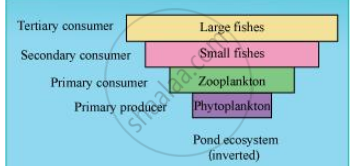Advertisements
Advertisements
प्रश्न
Describe with examples of pyramids of number, and biomass.
उत्तर १
There are three types of pyramids:
- Pyramid of numbers
- Pyramid of energy
- Pyramid of biomass
- Pyramid of numbers:
It is a graphical representation of the number of individuals present at each trophic level in the food chain of an ecosystem. The pyramid of numbers can be upright or inverted depending on the number of producers. For example, in a grassland ecosystem, the pyramid of numbers is upright. In this type of food chain, the number of producers (plants) is followed by the number of herbivores (mice), which in turn is followed by the number of secondary consumers (snakes) and tertiary carnivores (eagles). Hence, the number of individuals at the producer level will be the maximum, while the number of individuals present at top carnivores will be the least.

On the other hand, in a parasitic food chain, the pyramid of numbers is inverted. In this type of food chain, a single tree (producer) provides food to several fruit-eating birds, which in turn support several insect species.
- Pyramid of biomass
A pyramid of biomass is a graphical representation of the total amount of living matter present at each trophic level of an ecosystem. It can be upright or inverted. In grasslands and forest ecosystems, the amount of biomass present at the producer level is higher than at the top carnivore level. In a pond ecosystem, the biomass of fish far exceeds the biomass of zooplankton (upon which they feed).


उत्तर २
- Pyramid of numbers:
- The relative number of individuals per unit area at different trophic levels constitutes the pyramid of numbers.
- In a most well-balanced ecosystem, the pyramid of number is upright i.e. producers are more in number than herbivores, and herbivores are more in number than carnivores.

Upright pyramid of number
c. However, a pyramid of numbers can also be inverted in some cases.
For e.g., a tree ecosystem represents an inverted pyramid of numbers. If we plot the number of insects on a single tree, smaller birds feeding on insects, and parasites on those birds, we get an inverted pyramid.
- Pyramid of biomass:
a. The amount of biomass per unit area at different trophic levels constitutes the pyramid of biomass.
b. In a most well-balanced ecosystem, the pyramid of biomass is upright i.e. biomass of producers is more than that of herbivores, and biomass of herbivores is more than that of carnivores.

Upright pyramid of biomass
c. However, the pyramid of biomass can also be inverted in some cases. For e.g., the Oceanic ecosystem shows an inverted pyramid of biomass. In this case, the biomass of phytoplanktons (producer) is less than that of zooplanktons and fishes.
APPEARS IN
संबंधित प्रश्न
Give diagrammatic representation of pyramid of numbers.
“It is often said that the pyramid of energy is always upright. On the other hand, the pyramid of biomass can be both upright and inverted.” Explain with the help if examples and sketches.
In an ecosystem dominated by trees, the pyramid (of numbers) is _________ type.
Distinguish between Upright and inverted pyramid.
Which organisms constitute the last trophic level?
“The pyramid of biomass is not always upright.” Explain the statement.
Answer the following question.
What is an ecological pyramid? Compare the pyramids of energy, biomass, and numbers.
Secondary consumers are __________.
Distinguish between the upright and inverted pyramid of biomass.
Which ecosystem has the maximum biomass?
Which one of the following is not used for construction of ecological pyramids?
Which of the following organism form the decomposers?
Which one of the following statements for pyramid of energy is incorrect, whereas the remaining three are correct?
Pyramid of biomass in terrestrial ecosystem shows sharp decline in
In an aquatic ecosystem, a mollusc typically belongs to-
Which of the following statements is not correct?
Pyramid of numbers is ______.
Name any two organisms which can occupy more than one trophic level in an ecosystem.
Organisms at a higher trophic level have less energy available. Comment.
What are the shortcomings of ecological pyramids in the study of ecosystem?
Write a short note on pyramid of numbers and pyramid of biomass.
(a) Draw a pyramid of numbers where a large number of insects are feeding on the leaves of a tree. What is the shape of this pyramid?
(b) Will the pyramid of energy be also of the same shape in this situation? Give a reason for your response.
A graphic representation of the biomass relationship between the producer and consumer in an ecosystem is called ______.
The biomass of a standing crop of phytoplankton is 4 kg/m2, which supports a large standing crop of zooplankton having a biomass of 11 kg/m2. This is consumed by small fishes having a biomass of 25 kg/m2, which are then consumed by large fishes with a biomass of 37 kg/m2.
Draw an ecological pyramid indicating the biomass at each stage and also name the trophic levels. Mention whether it is an upright or inverted pyramid.
Give scientific reasons:
The pyramid of energy is always upright.
